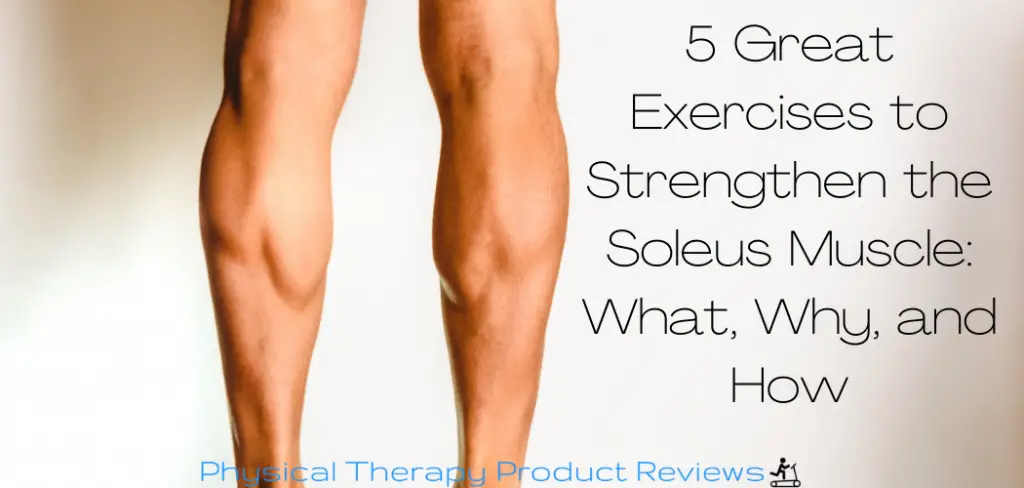One of the most underrated muscles in the body is the Soleus. The Soleus is a deep muscle in the calf that plays an important role in stabilizing the ankle and keeping our bodies upright and is the most active muscle during running.
It’s often overlooked, but it’s critical to keep this muscle strong if you want to prevent injuries and perform at your best. Yet, this muscle is rarely targeted in specific strengthening programs.
We will help fix that problem and reduce the amount of running injuries at the same time.
This post will cover the Soleus muscle, why it’s important, and the 5 best exercises to strengthen it.
What is the Soleus Muscle?
The Soleus muscle is a deep calf muscle that originates from the back of the lower leg below the knee and attaches to the Achilles tendon. It’s responsible for stabilizing the ankle and keeping our bodies upright. The Soleus muscle is active during running, walking, and standing.

The Soleus is a powerful plantar flexor which means pushing the foot down like a gas pedal, but its role is most important in weight-bearing positions.
Why is the Soleus Muscle Important
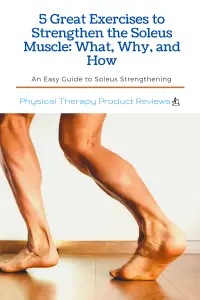
In weight-bearing activities such as standing, it prevents our body from falling forward on top of our ankles. The Soleus is working nearly all day to prevent us from falling forward! The poor muscle never gets a break until we sit down.
The Soleus is also extremely important during dynamic activities such as running and jumping. The Soleus is the most active muscle during running, yet it’s one of the most commonly undertrained muscles.
This is one of the reasons that the Soleus is the most injured muscle in Runners.
Common Soleus Injuries
Soleus Strain
The most common injury to the Soleus is a muscle strain or a small tear in the muscle. This can happen when the muscle is overloaded from too much training or a sudden change in training volume.
These injuries can take anywhere from 3 weeks to up to 3 months or longer to heal, depending on the severity of the strain and how quickly you can start pain-free strengthening rehab.
Achilles Tendonitis
Achilles Tendonitis is another common injury caused by overuse and weakness. The Achilles tendon is the large tendon that attaches the Soleus muscle to the heel bone. Achilles tendonitis is a common injury in runners and can be debilitating if not treated properly.
The good news is that strengthening the Soleus muscle can help prevent both Soleus strains and Achilles Tendonitis.
If you have Achilles Tendonitis, it’s important to focus on lengthening and strengthening both the Soleus and Gastrocnemius muscles.
Now that we know more about the Soleus muscle let’s get into the strengthening exercises.
5 Great Exercises to Strengthen the Soleus Muscle
Wall squats with Soleus Heel Raises
One of the best exercises to strengthen the Soleus muscle is the wall squat with heel raises.
This exercise targets the Soleus and Gastrocnemius muscles and the quads and glutes.
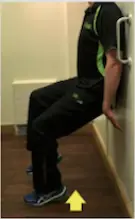
It’s one of the best exercises that athletes and runners can do because it truly works the entire lower body. After all, you are holding a wall squat.
To do this exercise:
- Stand with your back against a wall and your feet shoulder-width apart.
- Slowly lower yourself into a squat position until your thighs are parallel to the ground.
- Hold this position for 30 seconds.
- While in this position, repeatedly raise up on your toes and hold for another 30 seconds.
- Repeat for three sets.
You should feel this in your thighs and deep within the calf muscles.
Bent Knee Single-Leg Heel Raises on a Stair
Another great exercise to strengthen the Soleus muscle is the bent knee heel raise. This exercise doesn’t take long to fatigue the muscles and is one where you can pinpoint where you feel it.
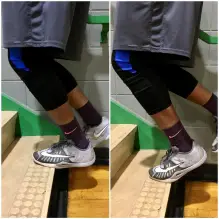
This exercise targets the Soleus and biases the bigger and larger Gastrocnemius. This is also one of my favorite exercises for runners and is easy to progress.
To do this exercise:
- Stand on the edge of a step or stair with the balls of both feet on the step and the heels hanging off.
- Try and balance on one leg with your knee bent.
- Keeping your knees bent, raise your heel as high as possible, and hold for two seconds.
- Slowly lower your heel below the step and raise it back up.
- Repeat for 15 reps before switching to the other leg.
You should feel this in your calf muscles, Soleus, and Achilles tendon.
Bosu Ball Squats with Forward Rocks
The Bosu Ball squat is another great piece of exercise equipment to help strengthen the Soleus muscle.
A Bosu ball adds an element of instability that makes the muscle work harder and builds strength faster. It’s one of our favorite pieces of home exercise equipment that everyone should have.
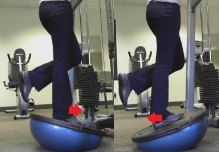
This exercise targets the Soleus, quads, and glutes and is a great exercise for athletes because it helps improve balance and coordination.
To do this exercise:
- Stand on a Bosu ball with your feet shoulder-width apart.
- Slowly lower yourself into a squat position, keeping your knees in alignment with your hip and toes.
- Hold this position for 30 seconds, and while you are holding position, rock forward and backward on the half ball.
- While you are rocking back and forth, try to make that move from the ankles and not the body moving forward and backward.
- Repeat for three sets.
You should feel this in your thighs and deep within the calf muscles.
Bent Knee Single-Leg Plyometric Hops
Plyometric hops are a great way to build explosive power in the Soleus muscle. The Soleus is the most active muscle in our legs during running and makes it an extremely important muscle to work in dynamic ways.
The single-leg plyo hops mimic the same type of loading that the Soleus has to go through with running and jumping activities. This involves a slow eccentric controlled landing with powerful propulsion forward.

This exercise also targets the glutes, quads, and gastrocnemius muscles.
To do this exercise:
- Start by standing on one leg with your knee bent at a partial angle.
- Swing your arms forward and jump up as high as possible.
- Land softly on the same leg and immediately jump again.
- Perform three sets of 30 seconds before switching to the other leg.
Single-Leg Eccentric Calf Raises on a Step
The soleus muscle is very active during the eccentric (lowering) phase of movements. This is why we want to do exercises that target this movement phase.
Slow and controlled eccentric calf raises are a great way to work on the Soleus muscle while also working on other important muscles like the Gastrocnemius. Even though this exercise works both muscles, it’s still important to do for many reasons.
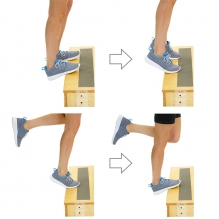
This exercise targets the soleus, gastrocnemius, and Achilles tendon.
To do this exercise:
- Start by standing on a step with your heels hanging off the edge.
- Keep your knees straight; raise your heels as high as possible and hold for two seconds.
- Slowly lower your heels below the step and raise them back up.
- Repeat for 15 reps before switching to the other leg.
Try to complete 3 sets of at least 15 reps for each leg.
Conclusion
The Soleus muscle is important in the lower leg that often gets overlooked. It’s important to keep this muscle strong and healthy to avoid injuries, and it’s an excellent muscle to work to improve performance.
These are five of the best exercises to strengthen the Soleus muscle. Try to incorporate them into your workout routine a few times a week to see and feel the benefits.
Let us know in the comments below which ones are your favorite or if you have any others that you would recommend.
Disclaimer: The information provided in this post is for educational purposes only. This is not a substitute for a medical appointment. Please refer to your physician before starting any exercise program.
